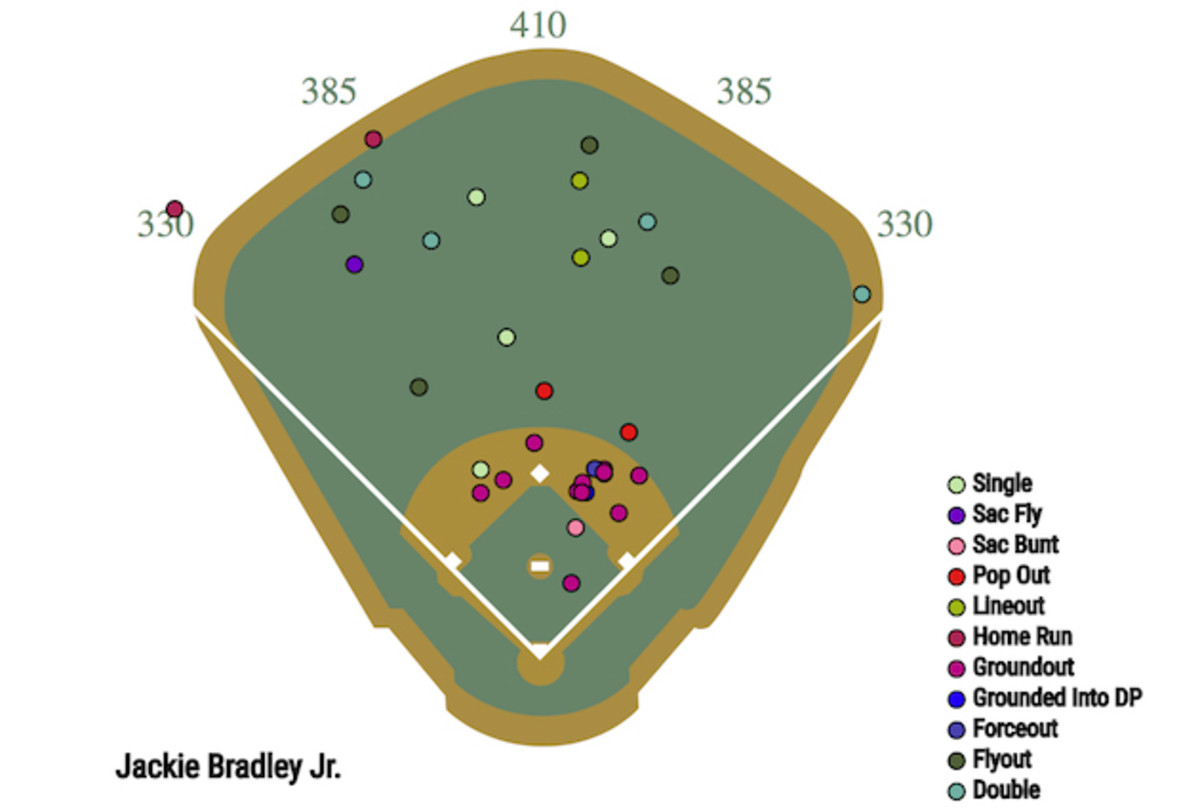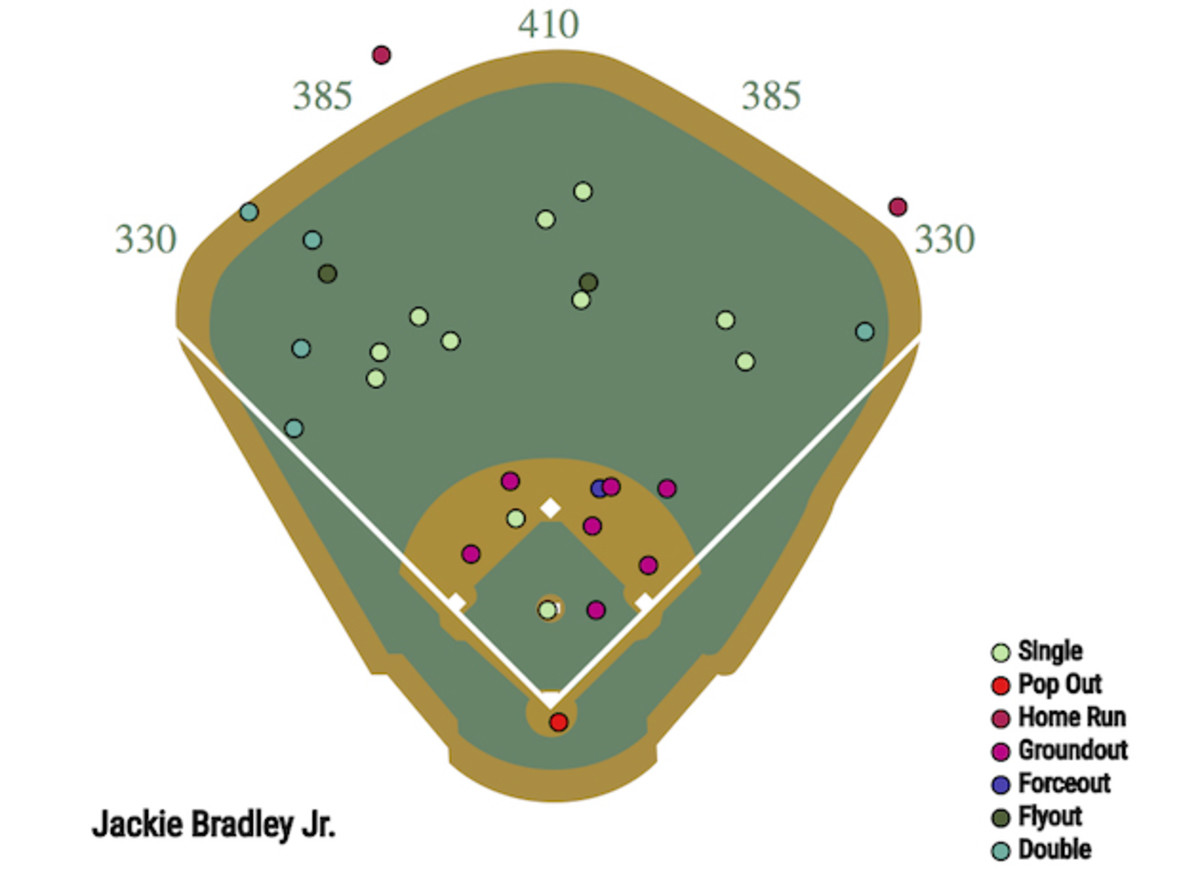Jackie Bradley Jr.’s adjusted swing playing a huge role in hitting streak

Jackie Bradley Jr. was one of the most hyped prospects in 2013 and ’14. He was ranked no worse than 32nd among all the prospects in the minors in 2013, and while Baseball America soured a bit on him the following season, they still had him at No. 50; Baseball Prospectus had him ranked 23rd and MLB.com placed him at No. 33.
But despite the constant adulation, Bradley never put together a dominant minor league season—a troubling sign if only because he was starting to get in danger of being a bit old for his level. Bradley played three years of college ball at South Carolina, so by time the Red Sox selected him with the 40th overall pick in the 2011 amateur draft, he was 21 years old. That almost turned 2014 into a make-good season for Bradley. There’s nothing wrong with a former college junior with an elite pedigree breaking into the majors at 24 years old, so long as he’s there to stay. Bradley, however, was not.
Amid hitting streak, red-hot Bradley Jr. shows new hitting approach
After hitting .198/.265/.266 in 2014, Bradley started ’15 with Triple A Pawtucket, where he spent nearly all of the first four months of the year. When he did make it back to Boston for good at the end of July, something had changed. His defense was predictably terrific, and he hit more than enough in 255 plate appearances to keep himself in Boston’s plans for the future. He may not have been anywhere near the level of Xander Bogaerts or Mookie Betts, but there’s plenty of room for a .249/.335/.498 hitter who plays plus defense in center field. With more exposure, it could have been rightly expected that Bradley’s average would rise while he’d lose a few points off that slugging percentage.
The former has come true, but the latter, thankfully, has not. Bradley is riding a 25-game hitting streak, and is now slashing .338/.390/.607 on the year, his age-26 season. In this week’s trade column, I explained why fantasy owners have to always ask themselves, “Hot streak or trend?” There’s ample reason to believe, in Bradley’s respect, it is a trend.
There is no appropriate way to talk about 2016 Bradley without first looking at ’14 Bradley. There’s a chance the player himself might not recognize tape of him in the box from two short years ago.
First, Bradley’s stance is wide open, almost like a left-handed Derrek Lee. His hands are incredibly active, and a bit lower than his shoulder. He strides toward the plate, though he never quite squares his feet, and his front foot comes down well before he starts his swing.
It’s important to remember that there is no right or wrong stance. Major league hitters find countless, diverse ways to set themselves up at the plate, but they generally all come to the same point before starting their swing. We can’t be sure whether or not Bradley was comfortable with this stance, but it certainly didn’t lead to success.
• Hitting report: Carlos Gomez’s struggles may be here to stay
Fast forward to August 2015. Bradley is back in the majors, playing mostly every day for the Red Sox after hitting .305/.382/.472 in 318 plate appearances at Pawtucket. Are we sure this is even the same hitter?
Gone is the wide-open stance. Gone is the incessant bat waggle. Bradley’s hands are higher and steady. He no longer strides toward the plate, because he doesn’t have to, and he has an exaggerated leg kick, with his foot coming down just before his swing begins. Bradley looks a lot more comfortable, and the results suggest that he is. This one left the yard, and in case you didn’t catch who was on the mound, it was Corey Kluber.
Just for fun, here’s Bradley hitting an absolute bomb off Eric Surkamp last week. Note that he hasn’t changed a thing this season.
We seem to have discovered the catalyst for Bradley’s 2016 breakout. Fittingly, it was put into practice in the largely unseen laboratory of Triple A ball. Still, if Bradley rested on those laurels, he wouldn’t be having as strong a year as he is. Remember, he hit .249 with a .335 OBP in the majors last season. Again, those are fine numbers when you’re hitting for power and playing great defense, but Bradley has found a level much better than fine this season, thanks, at least in part, to improved plate coverage.
Pitching report: When starters run dry, consider non-closer relievers
Bradley’s strikeout rate this season is 20.8%, down from 27.1% last year and 28.6% in 2014. Bradley isn’t simply making more contact this season. He’s doing it while simultaneously taking away what used to be a hole in the zone for him.
Even when Bradley was putting things together in August and September of last season, he struggled with pitches on the outer-third of the plate. When he made contact with those pitches, the results weren’t bad at all. He hit .272 with a .303 isolated slugging percentage on pitches Pitch F/X classified as in the zone and away from Bradley. The issue was making contact. Bradley had a 21.4% whiff rate on pitches away from him. Take a look at his spray chart on pitches away, which we can do thanks to the inimitable Statcast, and it becomes clear why Bradley whiffed so much on outside pitches.

That’s a surprising number of balls in play back up the middle and to Bradley’s pull side on outer-third pitches. That’s suggestive of a bad approach that had Bradley pulling off pitches away, which will invariably lead to more empty swings. Compare that with his spray chart on outside pitches this season.

That’s a much healthier distribution, with more balls hit to straightaway left or down the left-field line already this year than he had in 255 plate appearances last season. This shouldn’t come as a surprise, but Bradley’s numbers on outer-third strikes this season are up across the board. He’s hitting .452 with a .312 ISO and has whiffed just 14.1% of the time.
Just like there isn’t an exact science for figuring when a prospect moves past the constant hype, there’s no definition of what makes a breakout season. You just know it when you see it. We’re seeing it from Bradley in 2016.
